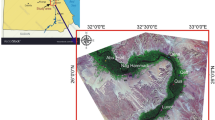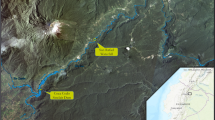Abstract
Detecting slope movement before landslides occur in mountain regions is crucial for disaster reduction. In October 2018, a gigantic landslide occurred on the Jinsha River, causing dammed-lake breach flood 500 km downstream. In this work, we used 25 Sentinel-2 images from November 2015 to August 2018 to explore the capability of this high temporal resolution optical images in detecting slope movement before the Jinsha River landslide. Normalized difference vegetation index (NDVI) was calculated to composite temporal profiles using all Sentinel-2 images. With this NDVI time series, unsupervised K-means classifier was applied to initially classify the study area and find the best thresholds for automatically extracting landslide scars in the image series. These extracted landslide scars were validated using interpreted results from two high spatial resolution images of similar dates in 2015 (user’s accuracy 89.7%, producer’s accuracy 83.6%) and 2018 (user’s accuracy 90.8%, producer’s accuracy 74.9%). After validation, extracted landslide scars of different years were counted and displayed in an RGB composite image to highlight slope movement. In addition, monotonous decrease/increase of NDVI was also observed, indicating continuous expansion of landslide scarps and movement of landslide head along the slope on the landslide surface. This work demonstrated the capability of Sentinel-2 time series images to capture slope movement with short revisit time at low cost. By incorporating other environmental information (such as elevation), this proposed method has the potential to consistently map pre-landslide slope movements over a large region.











Similar content being viewed by others
Change history
22 May 2019
The published version of this article, unfortunately, contained error.
References
Baidu (2018) http://baike.baidu.com/item/金沙江堰塞湖/22921677?/fr=aladdin. Accessed on 02 March 2019
Coluzzi R, Imbrenda V, Lanfredi M, Simoniello T (2018) A first assessment of the Sentinel-2 level 1-c cloud mask product to support informed surface analyses. Remote Sens Environ 217:426–443. https://doi.org/10.1016/j.rse.2018.08.009
Deng C, Zhu Z (2018) Continuous subpixel monitoring of urban impervious surface using Landsat time series. Remote Sens Environ. https://doi.org/10.1016/j.rse.2018.10.011
Elhag M, Alshamsi D (2019) Integration of remote sensing and geographic information systems for geological fault detection on the island of Crete, Greece. Geosci Instrum Method Data Syst 8:45–54. https://doi.org/10.5194/gi-8-45-2019
Fan X, Xu Q, Scaringi G, Dai L, Li W, Dong X, Zhu X, Pei X, Dai K, Havenith H-B (2017) Failure mechanism and kinematics of the deadly June 24th 2017 Xinmo landslide, Maoxian, Sichuan, China. Landslides 14:2129–2146. https://doi.org/10.1007/s10346-017-0907-7
Fan X, Xu Q, Alonso-Rodriguez A, Subramanian S, Li W, Zheng G, Dong X, Huang R (2019) Successive landsliding and damming of the Jinsha River in eastern Tibet, China: prime investigation, early warning, and emergency response.Landslides 1–8. https://doi.org/10.1007/s10346-019-01159-x
Fiorucci F, Ardizzone F, Mondini AC, Viero A, Guzzetti F (2018) Visual interpretation of stereoscopic NDVI satellite images to map rainfall-induced landslides. Landslides. 16:165–174. https://doi.org/10.1007/s10346-018-1069-y
Gascon F, Bouzinac C, Thépaut O, Jung M, Francesconi B, Louis J, Lonjou V, Lafrance B, Massera S, Gaudel-Vacaresse A, Languille F, Alhammoud B, Viallefont F, Pflug B, Bieniarz J, Clerc S, Pessiot L, Trémas T, Cadau E, De Bonis R, Isola C, Martimort P, Fernandez V (2017) Copernicus sentinel-2A calibration and products validation status. Remote Sens 9:584
Igwe O (2018) The characteristics and mechanisms of the recent catastrophic landslides in Africa under IPL and WCOE projects. Landslides 15:2509–2519. https://doi.org/10.1007/s10346-018-1064-3
Intrieri E, Raspini F, Fumagalli A, Lu P, Del Conte S, Farina P, Allievi J, Ferretti A, Casagli N (2018) The Maoxian landslide as seen from space: detecting precursors of failure with Sentinel-1 data. Landslides 15:123–133. https://doi.org/10.1007/s10346-017-0915-7
Lacroix P, Berthier E, Maquerhua ET (2015) Earthquake-driven acceleration of slow-moving landslides in the Colca valley, Peru, detected from Pléiades images. Remote Sens Environ 165:148–158. https://doi.org/10.1016/j.rse.2015.05.010
Lacroix P, Bièvre G, Pathier E, Kniess U, Jongmans D (2018) Use of Sentinel-2 images for the detection of precursory motions before landslide failures. Remote Sens Environ 215:507–516. https://doi.org/10.1016/j.rse.2018.03.042
Leprince S, Barbot S, Ayoub F, Avouac JP (2007) Automatic and precise orthorectification, coregistration, and subpixel correlation of satellite images, application to ground deformation measurements. IEEE Trans Geosci Remote Sens 45:1529–1558. https://doi.org/10.1109/TGRS.2006.888937
Lu P, Casagli N, Catani F, Tofani V (2012) Persistent scatterers interferometry hotspot and cluster analysis (psi-hca) for detection of extremely slow-moving landslides. Int J Remote Sens 33:466–489. https://doi.org/10.1080/01431161.2010.536185
Notti D, Giordan D, Calo F, Pepe A, Zucca F, Galve JP (2018) Potential and limitations of open satellite data for flood mapping. Remote Sens 10:1673. https://doi.org/10.3390/rs10111673
Sanchez YS, Martinez-Grana A, Frances FS, Picado MM (2018) Mapping wildfire ignition probability using sentinel 2 and LiDAR (Jerte Valley, Caceres, Spain). Sensors 18:826. https://doi.org/10.3390/s18030826
Stumpf A, Malet J-P, Delacourt C (2017) Correlation of satellite image time-series for the detection and monitoring of slow-moving landslides. Remote Sens Environ 189:40–55. https://doi.org/10.1016/j.rse.2016.11.007
Tomás R, Li Z, Lopez-Sanchez JM, Liu P, Singleton A (2016) Using wavelet tools to analyse seasonal variations from InSAR time-series data: a case study of the Huangtupo landslide. Landslides 13:437–450. https://doi.org/10.1007/s10346-015-0589-y
Wasowski J, Bovenga F (2014) Investigating landslides and unstable slopes with satellite multi temporal interferometry: current issues and future perspectives. Eng Geol 174:103–138. https://doi.org/10.1016/j.enggeo.2014.03.003
Wright TJ (2002) Remote monitoring of the earthquake cycle using satellite radar interferometry. Philos Trans A Math Phys Eng Sci 360:2873–2888
Xinhua N (2018a) http://www.xinhuanet.com/english/2018-11/15/c_137609161.htm. Accessed on 16 December 2018
Xinhua N (2018b) http://tibet.news.cn/2018-10/14/c_137531836.htm. Accessed on 02 March 2019
Xu Q, Zheng G, Li W, He C, Dong X, Guo C, Feng W (2018) Study on successive landslide damming events of Jinsha River in Baige village on October 11 and November 3, 2018. J Eng Geol 26:1534–1551. https://doi.org/10.13544/j.cnki.jeg.2018-406
Yang W, Qi W (2017) Spatial-temporal dynamic monitoring of vegetation recovery after the Wenchuan earthquake. IEEE J Sel Top Appl Earth Observ Remote Sens 10:868–876. https://doi.org/10.1109/jstars.2016.2616511
Yang W, Wang M, Shi P (2013) Using modes ndvi time series to identify geographic patterns of landslides in vegetated regions. IEEE Geosci Remote Sens Lett 10:707–710
Yang W, Qi W, Wang M, Zhang J, Zhang Y (2017) Spatial and temporal analyses of post-seismic landslide changes near the epicentre of the Wenchuan earthquake. Geomorphology 276:8–15. https://doi.org/10.1016/j.geomorph.2016.10.010
Zhang X, Wang M, Liu K, Xie J, Xu H (2018) Using NDVI time series to diagnose vegetation recovery after major earthquake based on dynamic time warping and lower bound distance. Ecol Indic 94:52–61. https://doi.org/10.1016/j.ecolind.2018.06.026
Zhu Z, Woodcock CE (2014) Continuous change detection and classification of land cover using all available Landsat data. Remote Sens Environ 144:152–171. https://doi.org/10.1016/j.rse.2014.01.011
Zhu X, Helmer EH (2018) An automatic method for screening clouds and cloud shadows in optical satellite image time series in cloudy regions. Remote Sens Environ 214:135–153. https://doi.org/10.1016/j.rse.2018.05.024
Acknowledgments
This work was supported by the National Science Foundation of China (NO. 41807500) and the National Key Research and Development Program of China (NO. 2017YFC1503000). We show gratitude to following MSc students: Jianghua Liao, Zhen Zhang, Yuhong Ma, and Lijuan Wang for their help in collecting some of the basic information for the Jinsha River landslide at the initial stage of this work. We also express our thanks to Prof. Qiang Xu and Dr. Weile Li from the Stake Key Laboratory of Geo-hazards for generously sharing Ziyuan-3 and Gaofen-2 high spatial resolution images in 2015 and 2018. Contributions by editor and reviewers of this work are also deeply appreciated.
Author information
Authors and Affiliations
Corresponding authors
Rights and permissions
About this article
Cite this article
Yang, W., Wang, Y., Sun, S. et al. Using Sentinel-2 time series to detect slope movement before the Jinsha River landslide. Landslides 16, 1313–1324 (2019). https://doi.org/10.1007/s10346-019-01178-8
Received:
Accepted:
Published:
Issue Date:
DOI: https://doi.org/10.1007/s10346-019-01178-8




